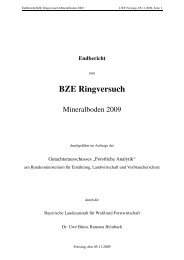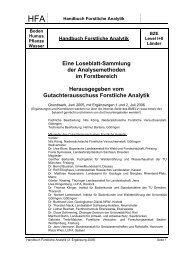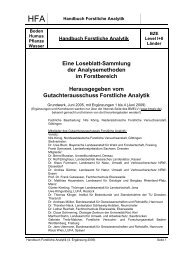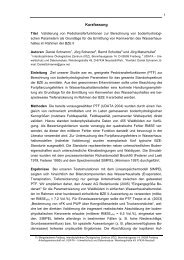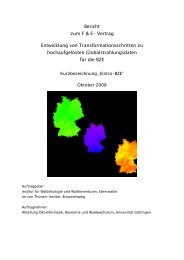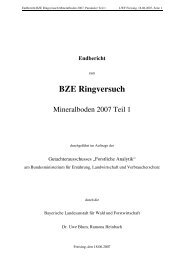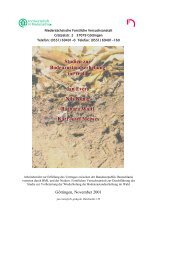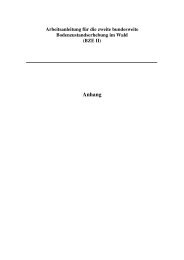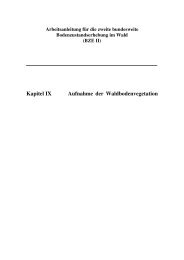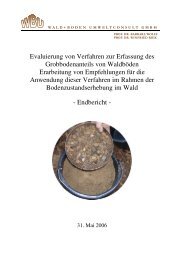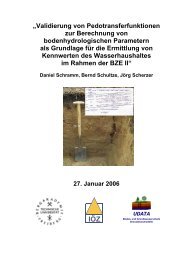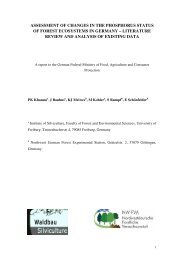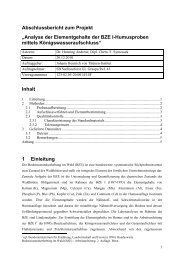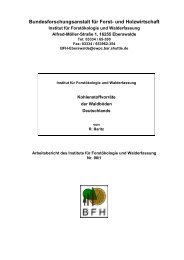assessment of changes in the phosphorus status of forest ...
assessment of changes in the phosphorus status of forest ...
assessment of changes in the phosphorus status of forest ...
Create successful ePaper yourself
Turn your PDF publications into a flip-book with our unique Google optimized e-Paper software.
it may be still worth consider<strong>in</strong>g a trial for a restricted number <strong>of</strong> sites such as<br />
<strong>in</strong>tensive monitor<strong>in</strong>g (Level II) sites.<br />
(b) The second possibility is to use surrogate measures such as near <strong>in</strong>frared (NIR) or<br />
mid <strong>in</strong>frared (MIR) spectroscopy and develop statistical models for which <strong>the</strong> data<br />
<strong>of</strong> selected samples for desorption set would be available. NIRS is a simple and<br />
cheap technique to handle a big set <strong>of</strong> samples as will be available for <strong>the</strong> BZE.<br />
There have been a number <strong>of</strong> studies reported <strong>in</strong> literature, where this technique<br />
has been tested for assess<strong>in</strong>g P <strong>in</strong> <strong>the</strong> soil and plant samples. It has shown to be<br />
useful for study<strong>in</strong>g retention <strong>of</strong> P by Al and Fe rich humus soils (Giesler et al<br />
2005).It is rout<strong>in</strong>ely already used <strong>in</strong> some laboratories for C and N analysis.<br />
In short <strong>the</strong> suggested development <strong>of</strong> a suitable method will <strong>in</strong>clude <strong>the</strong> follow<strong>in</strong>g<br />
steps:<br />
1. Prelim<strong>in</strong>ary experiment on a small set <strong>of</strong> samples from BZE collective to test <strong>the</strong><br />
suitability <strong>of</strong> different anion based extractants <strong>in</strong>clud<strong>in</strong>g anion res<strong>in</strong> exchange<br />
methods. The subset <strong>of</strong> BZE1 samples that cover <strong>the</strong> wide variation <strong>in</strong> soil<br />
conditions encountered.<br />
2. A set <strong>of</strong> suitable soil samples will be selected from BZE collective to develop<br />
desorption procedure <strong>in</strong>clud<strong>in</strong>g <strong>the</strong> fitt<strong>in</strong>g <strong>of</strong> <strong>the</strong> desorption iso<strong>the</strong>rm to obta<strong>in</strong> <strong>the</strong><br />
capacity and <strong>the</strong> rate functions. The number <strong>of</strong> samples will depend upon <strong>the</strong><br />
different types <strong>of</strong> soil matrix to be <strong>in</strong>cluded <strong>in</strong> prediction models.<br />
3. This set <strong>of</strong> soil samples will be used for NIRS and/or MIRS analysis and<br />
appropriate calibration and validation models will be developed to obta<strong>in</strong><br />
parameters <strong>of</strong> desorption iso<strong>the</strong>rms.<br />
4. All soil samples <strong>in</strong> <strong>the</strong> BZE collective will be analysed with NIRS or MIRS to<br />
predict <strong>the</strong> desorption parameters. Desorption parameters will <strong>the</strong>n provide soil<br />
data to assess <strong>the</strong> <strong>status</strong> and <strong>changes</strong> <strong>in</strong> <strong>the</strong> P supply <strong>of</strong> soils.<br />
3.5 Summary <strong>of</strong> P <strong>in</strong> Forest Soils<br />
Dynamics <strong>of</strong> P <strong>in</strong> <strong>forest</strong> soils <strong>in</strong>volve both <strong>the</strong> organic and <strong>in</strong>organic fractions which<br />
are <strong>in</strong> different dynamic equilibria <strong>in</strong>volv<strong>in</strong>g various processes <strong>of</strong> m<strong>in</strong>eralization,<br />
immobilization, desorption, solubilisation, retention and uptake. It is <strong>the</strong>refore hard to<br />
72



